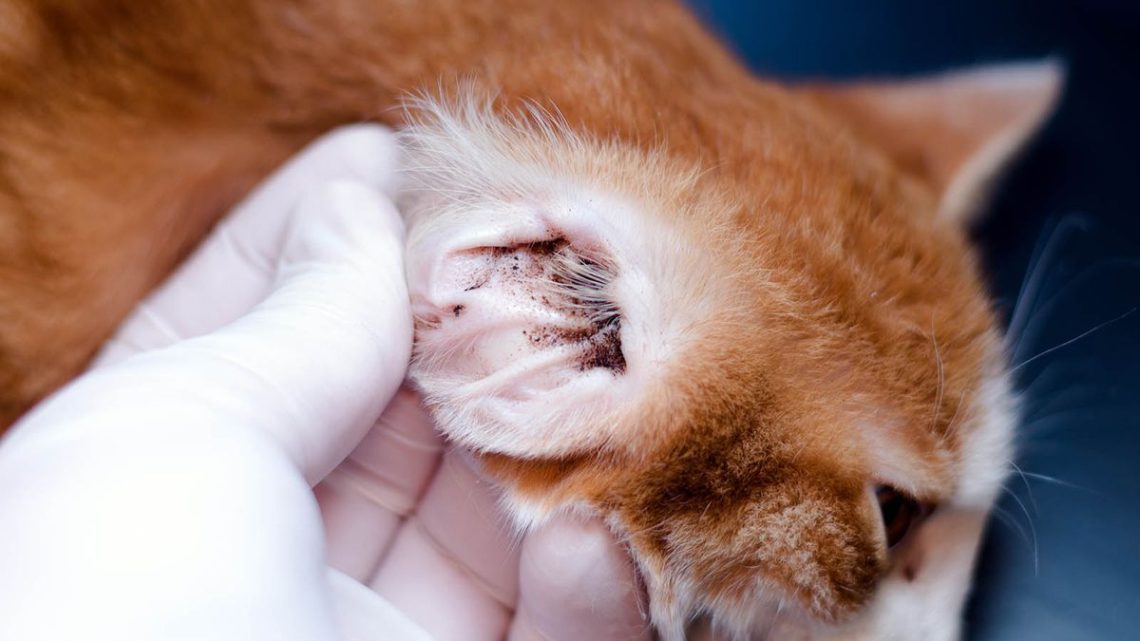
ວິທີການກໍາຈັດແມງຫູໃນແມວ: ອາການຂອງພະຍາດ, ການປິ່ນປົວດ້ວຍຢາແລະວິທີແກ້ໄຂອື່ນໆ
ເນື້ອໃນ
- ລັກສະນະຂອງພະຍາດ
- Danger of an ear mite for a cat
- How can a pet get infected?
- ອາການຂອງແມງຫູໃນແມວ
- Diagnosis otodecosis
- ການປິ່ນປົວພະຍາດ
- Medicines for ticks
- How to treat the ears
- Concomitant therapy
- ການປິ່ນປົວດ້ວຍວິທີແກ້ໄຂ folk
- The main rules of treatment
- Are there strong remedies for ear mites?
- How long does it take to treat otodecosis
- ຄົນເຮົາສາມາດຕິດເຊື້ອໄດ້
- How to prevent otodecosis
ລັກສະນະຂອງພະຍາດ
Otodecosis in cats is caused by the microscopic (about ½ mm) insect Otodectes cynotus. The parasite has a whitish oval body and jointed limbs. It loves moisture and warmth, therefore it parasitizes inside the animal’s ear canal, feeding on skin scales, blood, and lymph. Outside the body of the host, the tick can live for about two months.
In most cases, the parasite affects both ears of the cat. The probability of infection is especially high in the warm and humid season – in spring and early autumn. The risk group is kittens under one year old and weakened animals. From the moment of infection to clear signs of the presence of a tick, it can take several years. The disease is especially pronounced when a bacterial infection is added to the skin damage by the parasite. Due to itching and pain, the exhausted pet cannot sleep and eat.
Danger of an ear mite for a cat
The ear mite, feeding on particles of the skin, leads to severe damage to it. If left untreated, a cat can develop serious health problems:
- unbearable itching causes constant scratching of the ears, which leads to damage to the capillaries, the appearance of extensive hematomas;
- bacterial and fungal infections penetrate into the places of skin damage, the inflammatory process begins, the ear tissues swell, turn red, fester;
- Gradually, inflammation passes to the tympanic membrane and into the inner ear – otitis media and myringitis develop.
Further delay in therapy will lead to weakening and then loss of hearing. Pain and itching interfere with normal rest and eating. The animal becomes irritated, nervous, aggressive. Over time, inflammation can penetrate the membranes of the brain, which will be fatal.
How can a pet get infected?
A cat can pick up ear mites on the street, in contact with sick animals or in walking areas. Most homeless cats suffer from otodecosis, so letting a pet go for a free walk is fraught with negative consequences.
The owner can pick up the parasite on shoes by accidentally walking in places where stray cats like to gather. The owner can bring the ear mite home even after petting someone else’s pet with otodecosis. In addition, there is a high probability of the disease in homes where there have already been (or are) cases of the disease in other animals.
Kittens can become infected at birth from a mother with ear mites. A variant of infection through bedding, carpets, home furniture or dishes is possible.
ອາການຂອງແມງຫູໃນແມວ
Symptoms of ear mites in cats at the beginning of the disease are practically absent. You should take your pet to the veterinarian if the following signs of the disease are found:
- frequent scratching of the ears, to bruising;
- head shaking, restlessness;
- discharge from the ear canal of liquid, sticky pieces of sulfur of a dirty gray or dirty brown color;
- glued wool on the ears;
- hair loss in the area of the ears;
- purulent sores on the outer ear;
- swelling and redness of the ears;
- ກິ່ນ unpleasant;
- the animal walks with its head bowed.
It is necessary to suspect otodecosis if the cat periodically shakes its head and scratches its ears. Discharge, smell and other signs appear later, when the disease takes an advanced form.
Diagnosis otodecosis
Even if there are seemingly obvious signs of an ear mite, the cat should be shown to the veterinarian. Similar symptoms can also appear with dermatoses, lichen, fungal and bacterial infections. In addition, there is another type of external microscopic parasite that lives on the ears of cats. Therefore, before starting treatment, it is required to conduct a diagnosis.
The diagnosis is made on the basis of examination and microscopic examination of scrapings from the surface of the auricle. Under a microscope, the doctor will quickly identify the parasite and prescribe the appropriate treatment.
If it is not possible to conduct laboratory diagnostics, you can try the home method. To do this, you need a black sheet of paper and a magnifying glass. You need to take some secretions from the inner surface of the pet’s auricle and smear it on paper. If there is a parasite, then on the leaf it looks like a moving whitish dot.
ການປິ່ນປົວພະຍາດ
Treatment of ear mites in cats is carried out in several directions:
- ear cleaning with special means;
- the use of the drug to destroy the parasite;
- the use of external antiparasitic agents;
- increase the immunity of the pet.
Medicines for ticks
Medicines for ear mites are presented in the form of ointments or drops. Among the large assortment, it is difficult to choose the right remedy on your own: you should take into account the degree of damage, the presence of concomitant infections, the age of the animal. In the treatment of otodecosis, the following medications are most often used.
ການກະກຽມ
Course of treatment, dosage
ຫມາຍເຫດ
Amidel
The gel is applied to the cleaned surface of the auricle 3-5 times with one week intervals.
Do not use on kittens under 2 months of age and cats during pregnancy.
Otoferonol Gold
Apply twice with a break in a week. Dosage – 3 drops in each ear.
Do not use on kittens under two months of age and pregnant cats. The tool destroys the parasite, has an anti-inflammatory effect.
Aversectin ointment
Apply 2-4 times, interval – 7 days.
Do not apply ointment to kittens under 2 months of age and during pregnancy.
Amitrazine
The course of treatment includes 4-5 procedures. The breaks between instillation are three days. Dosage – ½ ml in one ear.
Do not use during pregnancy cats.
Decta
Ear drops are used every five days, 4-5 drops once. In total, 2-4 procedures are required.
The product is not suitable for babies under 30 days old and pregnant cats. The composition includes an antibacterial component.
In difficult situations, the veterinarian will prescribe injections or antibacterial drugs.
How to treat the ears
Treat the auricles of a fluffy pet as follows.
- Before using the drug, the cat’s ears are cleaned of accumulated plaque. This will allow the medicine to penetrate deeper. For cleaning, special solutions or ordinary vegetable oil are used. The surface of the ear is wiped with a cotton pad or a piece of bandage soaked in the solution. Do not instill hydrogen peroxide or other means inside the ear canal!
- On a clean surface of the auricle, ointment or drops are applied in the amount indicated in the annotation to the drug.
- In order for the medicine to be evenly distributed, the ear needs to be massaged a little.
- If drops are used, then the cat’s head should be held to prevent shaking and spilling the medicine out.
- In conclusion, it is recommended to wipe the auricle again with a cotton pad soaked in the same agent.
Attention: it is not recommended to use cotton buds to treat the ears of an animal – the likelihood of injury to the ear canal and infection in the deep sections of the ear increases.
Concomitant therapy
During the treatment of ear mites, it must be borne in mind that the parasite can pass to the body of the cat, therefore, in parallel with the treatment of the auricles, antiparasitic procedures of the whole body should be carried out. To do this, it is enough to apply a few drops of a special preparation to the scruff of the pet or treat it with a spray. Among the sprays, Frontline and Cyodrin are the most popular. Be sure to make sure that the animal does not lick the wool for a certain time.
You should also take care of your furry pet’s immune system. The stronger the immune system, the faster the recovery will come, and the greater the chance of avoiding re-infection. The diet of a cat should contain a large amount of vitamins, be varied. You can add ready-made vitamin complexes to the feed. It is also recommended to conduct a course of therapy with drugs that enhance the body’s defenses – Gamavit, Tentravit.
ການປິ່ນປົວດ້ວຍວິທີແກ້ໄຂ folk
Treatment with folk remedies is permissible only at the very beginning of the development of the disease. With pronounced symptoms of an ear mite, they are suitable only as auxiliary methods. In addition, folk recipes can be used to prevent otodecosis.
One of the common remedies for cat ear care is green tea. Its strong infusion acts as an antiseptic. After the tea leaves have cooled, a cotton pad is moistened in it and the external auditory canal is wiped. The decoction can be used both for cleansing the ears before instillation of drops, and for regular care.
Hydrogen peroxide is used in the same way. It can not be buried in the ears, it is only allowed to moisten the crusts and wipe the surface of the cartilage.
To clean the auricles, vegetable oils are widely used. Any oil is suitable: olive, sunflower, vaseline, camphor-based. Oils are not suitable for the prevention of the disease, but they allow you to soften and remove scabs. After treatment with oil, the ears of the animal should be wiped with a clean disc so that the oil film does not interfere with the absorption of the medicine.
Sometimes, to combat ear mites in cats, it is recommended to use gruel or garlic juice, but its irritating property in this case will be stronger than antiseptic. In addition, garlic still cannot destroy the parasite, so this remedy must be discarded.
The main rules of treatment
When treating otodecosis at home, you need to follow a number of recommendations.
- If there are several animals in the house, all should be treated for ticks, regardless of the presence or absence of the parasite. For kittens and cats during pregnancy, it is better to use products in the form of a spray.
- Be sure to treat your pet’s bedding with an antiparasitic agent. If possible, then it should be boiled.
- Until the product applied to the withers has dried, it is important to keep an eye on the cat, not letting her lick her lips.
- Since recovery depends on the state of immunity, it is necessary to provide the pet with a balanced diet and include vitamin complexes in it. Take the animal out to fresh air periodically.
- Ear mites can also live on furniture, carpets, floor crevices and other objects, so wet cleaning should be done by adding an acaricidal agent to the water.
- To clean the ears of a cat, do not use products based on ethyl alcohol.
Are there strong remedies for ear mites?
There is a stronger way to get rid of ear mites than ointments and drops. These are injections. Their distinctive feature is that you can get rid of all parasitic insects at the same time (if they are present). At the same time, the use of such a method is fraught with negative consequences – the active substances are toxic to the cat’s body. Their use can provoke allergies, baldness, dermatoses and other complications. The use of such drugs is contraindicated during pregnancy of a cat and for kittens.
How long does it take to treat otodecosis
The duration of treatment for an ear mite depends on the degree of its spread, the presence of concomitant diseases, and the general condition of the pet. Uncomplicated course of the disease can be cured within 1-3 weeks. If the pathology has led to complications, there is a secondary infection, then the treatment can be delayed for several months.
ຄົນເຮົາສາມາດຕິດເຊື້ອໄດ້
When an ear mite is found in a cat, many owners ask themselves: is this disease transmitted to humans? Otodekoz does not pose a danger to humans. But for pets, such as dogs, it is highly contagious. Simultaneously with the treatment of one pet, it is necessary to carry out preventive measures for another.
How to prevent otodecosis
Mite infestation in cats can be prevented in most cases. To do this, you should adhere to such preventive measures:
- periodically inspect the pet’s auricles for scratching, redness, swelling, scabs;
- regularly clean the external auditory canal;
- do not allow communication with unfamiliar animals;
- strengthen the cat’s immune system.
Careful attention to the pet and a timely visit to the doctor will help to avoid health problems.





